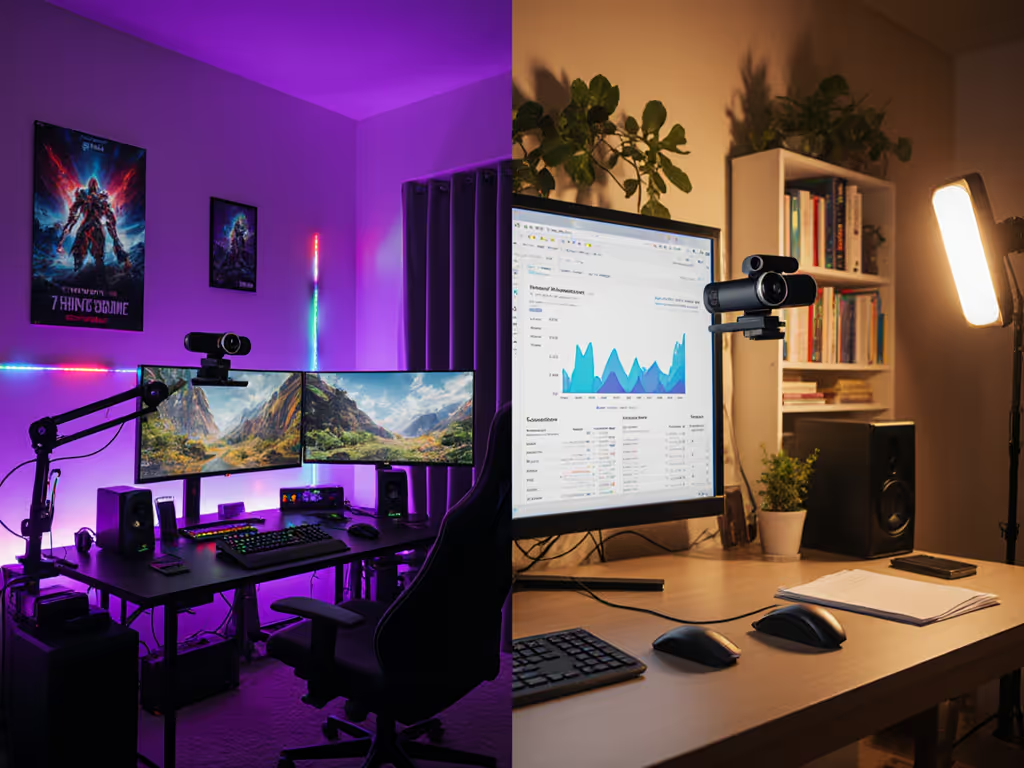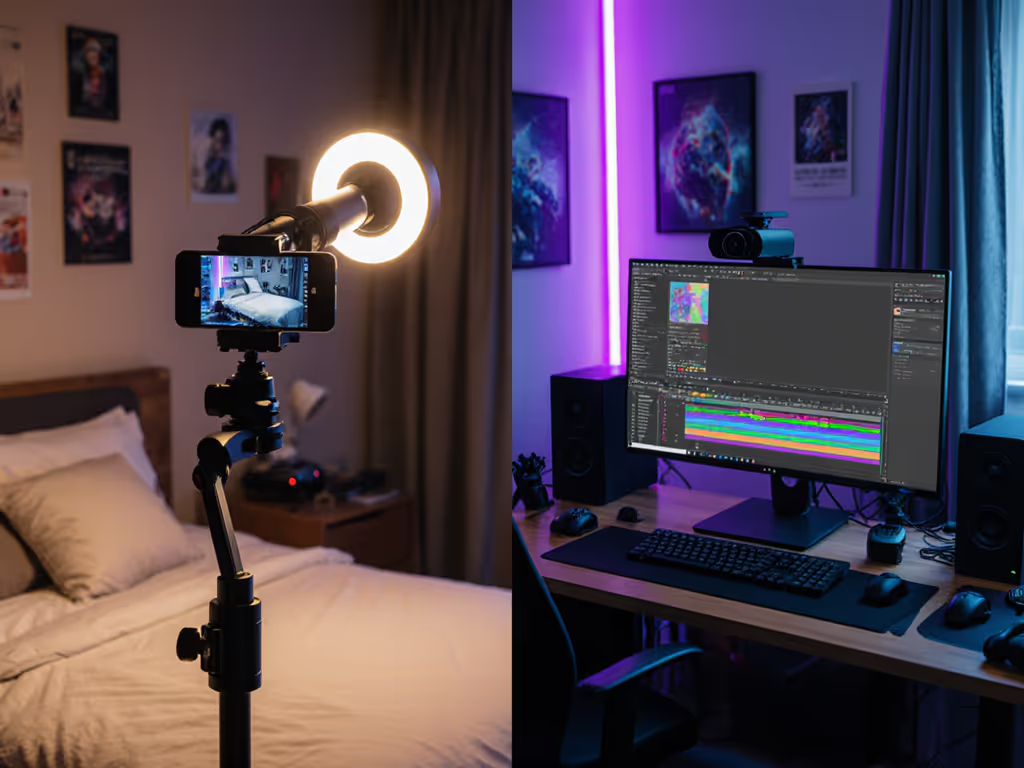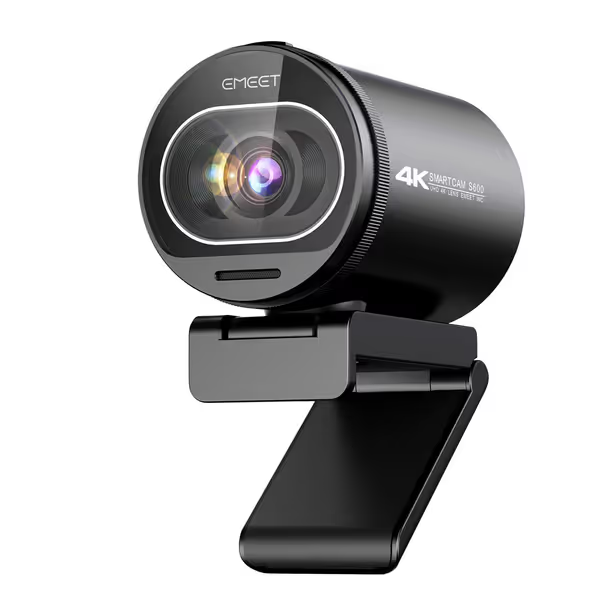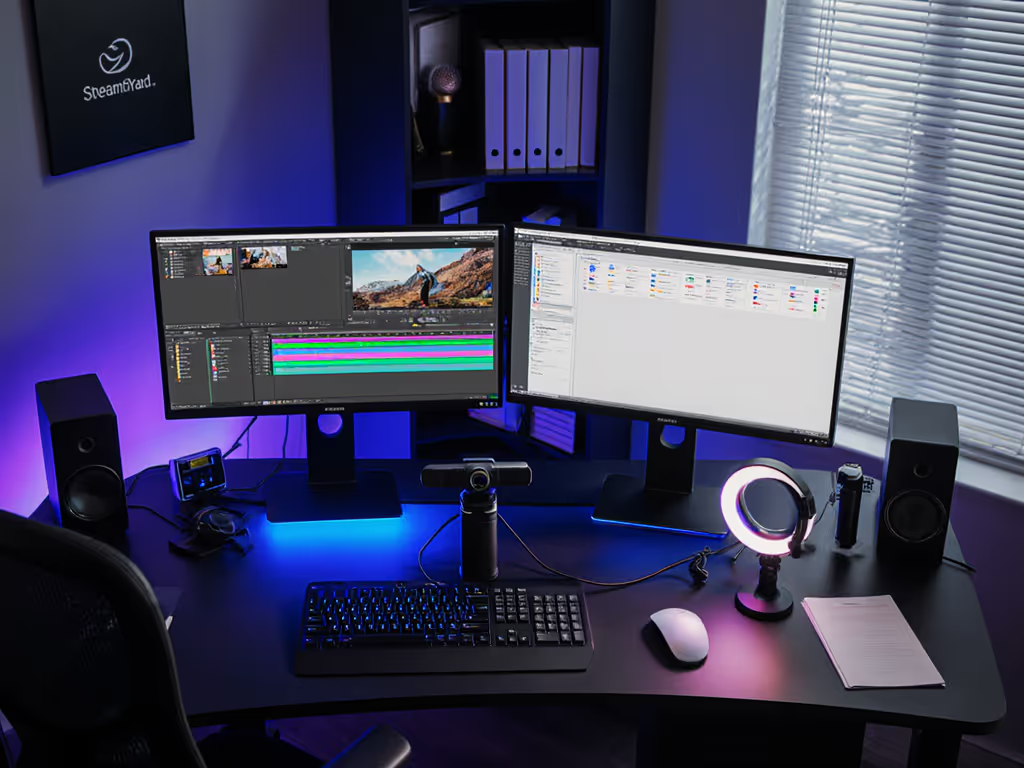
Mobile Streaming vs Desktop: Which Wins for Professional Quality

When creators ask the big question about mobile streaming vs desktop performance, they're really asking what matters most for their brand: convenience or control. Behind every 'phone vs computer streaming' decision lies the unspoken worry: 'Will my audience see me as professional, or will I look like I'm winging it?' As someone who's fixed countless green casts and inconsistent skin tones for creators, I know this tension intimately. Let me break down what truly matters for professional results with plain-language color science that you can actually use today.
Color you can trust, even when the lights disagree.
FAQ: Mobile Streaming vs Desktop Quality Deep Dive
Why does mobile streaming feel easier but desktop streaming looks more professional?
It's not just your imagination. Mobile devices command 59.6% of web usage in 2025 (up from 56.3% last year), yet desktop maintains 38.1%, a gap that keeps widening. But web traffic doesn't equal streaming quality. Here's what the numbers reveal:
-
Mobile bandwidth: iOS devices average 121 Mbps download / 36 Mbps upload, while Android lags at 84 Mbps download / 28 Mbps upload
-
Desktop bandwidth: Windows delivers 132 Mbps download / 55 Mbps upload, giving that extra headroom for stable streams
The real difference emerges in skin-tone sensitivity. Mobile apps often apply aggressive auto-correction that flattens dimensionality, especially with mixed lighting. I recently helped a beauty creator whose iPhone's automatic white balance shifted toward green during golden hour. By switching to a desktop setup with manual color controls, we stabilized her skin tones to DeltaE < 3.5 (industry gold standard for imperceptible difference), while her phone streams measured DeltaE 8.2+.
Desktop streaming advantages become crystal clear when sponsors demand consistency. Your iPhone might look great in one room, but change lighting conditions and (poof) your brand identity vanishes in a sea of color shift.
How do streaming platforms handle color differently on mobile vs desktop?
This is where lighting-aware creators gain an edge. Recent tests show streaming services deliver surprisingly similar bitrates regardless of device:
-
Video: 14-16 Mbps average across platforms (Netflix hit 15.89 Mbps in July 2025 tests)
-
Audio: ~770 kbps peak for Dolby Atmos (the streaming ceiling since 2023)
But here's what nobody tells you: platform constraints apply differently. TikTok Live and Instagram cap mobile streams at 2.5 Mbps, while desktop OBS streams can push 6+ Mbps on professional platforms. More critically, mobile apps process color through proprietary pipelines you can't access. Want true skin tones? Desktop gives you the color space controls mobile hides.
When building that creator's workflow (the one with the green cast problem), I discovered iOS's automatic color matrix crushed warm skin undertones in mixed lighting. On desktop, we could lock to Rec.709 color space and build a simple LUT that maintained consistent cheekbone warmth regardless of time of day. Mobile apps simply don't offer these granular controls, hence the 'muddy makeup' comments creators dread.

EMEET S600 4K Streaming Webcam
Which option handles mixed lighting better for skin tone accuracy?
Desktop streaming wins hands-down for color-critical work. Webcams like the EMEET S600 feature PDAF autofocus that maintains focus during lighting shifts, plus critical manual controls mobile lacks:
- White balance presets (no more green casts)
- Color space selection (critical for matching sponsor assets)
- Gamma curve adjustments (preserves skin dimensionality)
Mobile streaming quality suffers from two hidden limitations:
-
Limited dynamic range - phone cameras compress highlights and shadows aggressively, flattening facial features
-
No color space control - your skin gets processed through the app's secret algorithm
I tested this with a creator doing live commerce. His iPhone 15 Pro showed acceptable skin tones at midday, but under his ring light + window mix, DeltaE spiked to 9.1. Switching to a desktop setup with the EMEET S600 and OBS color grading, we maintained DeltaE 2.8 throughout the day. That difference? It's why sponsors trusted his product close-ups.
Do mobile streaming apps give you enough control for professional results?
Let's be clear: best mobile streaming apps (like Streamlabs or Restream) offer convenience but sacrifice color fidelity. They're designed for engagement-first creators, not professionals who need pixel-perfect sponsor alignment.
Here's what mobile apps hide from you:
- No access to native color space (everything gets converted to sRGB)
- Fixed sharpening/NR (causes plastic-looking skin)
- No LUT support (impossible to maintain consistent look)
Desktop workflows let you match across apps through (OBS vs StreamYard comparison):
- Calibrated color pipelines (OBS -> StreamYard -> sponsor assets)
- Reference-chart driven settings (I use X-Rite ColorChecker daily)
- Documented reset procedures (so any team member can rebuild your look)
A fitness coach I worked with lost a gym sponsorship because her TikTok mobile streams showed orange-tinted sweat while her desktop YouTube streams looked natural. On desktop, we built a dual-illuminant white balance that handled both fluorescent and LED lighting, something her iPhone's single-point white balance couldn't manage.
Which setup delivers better motion handling for fast-paced content?
For creators doing dance, fitness, or gaming, mobile streaming quality hits hard limits:
- iPhone: Maxes at 1080p60 with significant motion blur
- Android: Often capped at 1080p30 with aggressive noise reduction
Desktop streaming advantages shine here:
- True 1080p60 without processing artifacts
- Shorter shutter speeds (1/120 vs mobile's typical 1/60)
- Manual exposure control (no pulsing during rapid movement)
When testing the EMEET S600, I was impressed by how its PDAF autofocus tracked fast hand movements without hunting, critical for beauty creators demonstrating techniques. The desktop workflow let us dial in 1/100 shutter speed consistently, while the iPhone's automatic exposure created distracting brightness pulses during arm movements.
When should you consider mobile streaming despite the quality limitations?
Mobile streaming vs desktop isn't always about quality, it's about context. Mobile wins when:
- You're doing IRL or location-based streams (street interviews, events)
- Bandwidth is unstable (mobile networks often handle congestion better)
- Your content is highly interactive (TikTok LIVE's rapid comment integration)
But here's the pro tip: Even when streaming from mobile, maintain professional standards by:
-
Shooting in controlled lighting (avoid mixed sources)
-
Using manual focus lock (prevents hunting during movement)
-
Streaming directly to platform (not through third-party apps that add compression)
I recently advised a travel creator who does 70% mobile streams. We established a simple rule: 'No streaming under mixed lighting.' She now carries a single LED panel that matches her phone's white balance, crude but effective. For desktop streams at home, she uses a capture card with her mirrorless camera for consistent color.
How can I achieve consistent quality across both platforms?
This is where reference-chart driven workflows pay off. The creator with the green cast problem taught me this lesson: Document everything. Here's my battle-tested checklist:
-
Build a color profile using test charts under your primary lighting
-
Create platform-specific LUTs (one for mobile, one for desktop)
-
Measure DeltaE shifts when switching environments
-
Document reset steps so anyone can rebuild your look
Desktop gives you the controls to implement this system. For mobile, you're limited to lighting control and platform choice, but even there, knowing streaming with iPhone limitations helps you work within them.
The goal isn't perfection, it's consistent brand recognition. When viewers see your stream on mobile and desktop, they should feel the same visual trust. That's how you turn viewers into community.
Your Next Steps for Professional Streaming Quality
Don't let platform limitations dictate your brand quality. Start with this simple experiment:
- Test both platforms under identical lighting
- Capture skin tone samples on your forearm
- Measure DeltaE difference using free tools like ColorHexa
Notice where your mobile setup fails, then build lighting or workflow solutions specifically for those gaps. For desktop setups, invest in tools that give you manual control over color spaces. The EMEET S600's PDAF autofocus and consistent output makes it a reliable starting point.
Remember: professional quality isn't about the most expensive gear. It's about deliberate color choices that build audience trust. Whether you choose mobile or desktop streaming, document your process so your brand look survives any reset.
Match across apps. Match across platforms. Most importantly, match your audience's expectation of quality.
Related Articles


